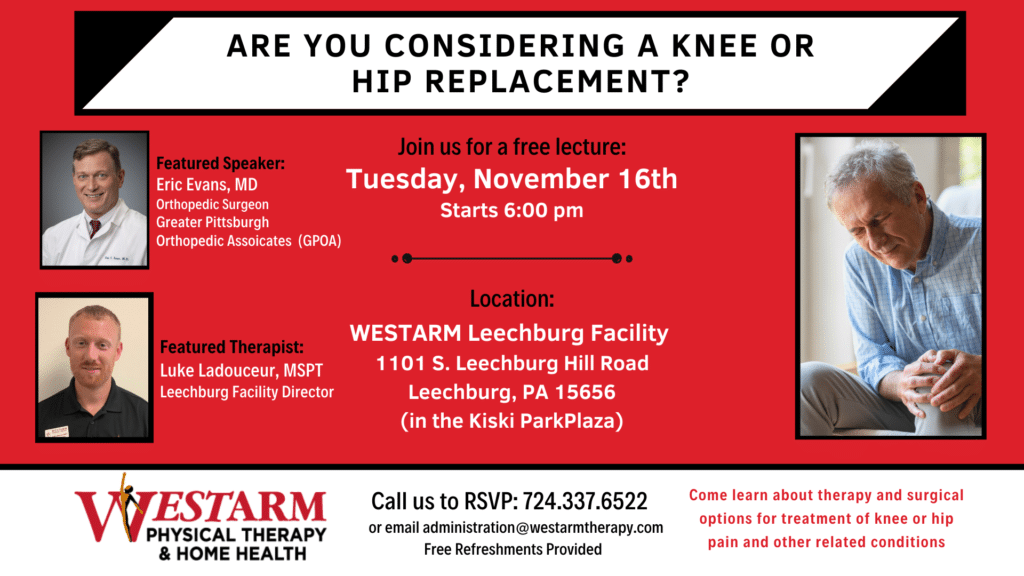
Experienced orthopeadic surgeon Dr. Eric Evans from Greater Pittsburgh Orthopeadic Group (GPOA) is teaming up with WESTARM Physical Therapy to give a free lecture to local residents of the Alle-Kiski Valley and it’s surrounding communities who are considering hip or knee replacement. The lecture is scheduled to take place at 6 p.m Tuesday, November 16th at WESTARM’s Leechburg facility. Facility Director Luke Ladouceur, MSPT, will join Dr. Evans in conducting the lecture.
RSVP for your spot at the lecture here or by calling us at 724-337-6522.
WESTARM hosts a series of lectures in order to help educate the communities in which we serve. The aim of these lectures is to help attendees ease their minds and ask any questions or voice any concerns they have about their potential upcoming surgery. Please check out some common myths about joint surgery provided by Temple Health.
Myth: Artificial Joints Are Only for People with Arthritis
Arthritis is one of the many conditions treated by replacing a damaged joint with an artificial implant. But pain, stiffness and swelling can also be caused by diseases, injuries and years of wear and tear.
If your quality of life is not the same as it used to be, and you’re having trouble doing everyday tasks like walking, climbing stairs or lifting your grocery bags, you may also benefit from joint replacement. And keep in mind that joint procedures range from total joint replacement to repairing the damaged parts of your joint.
Myth: Hip and Knee Replacements Don’t Last – I’ll Need Another Operation Eventually
While there is always a chance that your artificial joint implant will wear down over time, studies show that statistically, knee and hip replacements can last for 15 to 20 years, or even longer. Depending on your age and other factors when you have your joint procedure, you may never need another procedure again.
Myth: I’m Too Young/Old for Joint Replacement Surgery
Joint overuse and injury can occur at any age – most often in your hips and knees. That’s because you use your hip and knee joints for everything, from carrying groceries, to lifting your kids onto your shoulders, to playing weekend sports. Wear and tear on these joints breaks down the protective cartilage between your bones, causing pain and inflammation.
The goal of joint replacement is to help patients of all ages move freely and live with minimal or no pain. Your provider will consider many factors – including your overall health – before recommending joint replacement as an option for you.
Myth: An Orthopaedic Surgeon Will Just Try to Talk Me Into a Procedure
An orthopaedic surgeon is a bone doctor with years of training and experience in working with patients who have acute joint injury or chronic joint pain from various conditions.
To find out if you’re a candidate for joint replacement, an orthopaedic surgeon will talk to you about your medical history, conduct a physical exam and may run some tests such as an X-ray or arthroscopy to view the extent of the damage. At that point, it may be that rest, medications (NSAIDs) and/or physical therapy are all you need.
If extensive damage has already occurred, you can discuss all your options with the surgeon, and even get a second opinion before you decide the best treatment for you.
Myth: I Don’t Have Time for a Long Recovery Following Joint Replacement
Even with total knee or hip replacement, you should expect to stand or begin walking with assistance the day of surgery. You will have initial pain as your surgical area heals, but as you work with your physical therapy team, you’ll learn how to strengthen the muscles around your joint.
Within a few weeks to months, you should be back to your daily activities once again.